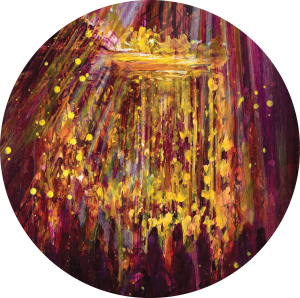Grasp the Light


Teves “gathers us in” and lifts us up , Grasp the Light,Teves “gathers us in” and lifts us up
I magine experiencing exhilarating light and joy. And then from one week to the next plunging into darkness and despair. The contrast alone can break a person.
The month of Teves seems to have this dynamic. The month begins with the last few days of Chanukah: days of light and celebration. Just a few short days later we’re thrust into three days designated as days of darkness and fasting.
The eighth of Teves marks the translation of the Torah into Greek which Chazal liken to the making of the Golden Calf and which led to the descent of darkness upon the world. The ninth of Teves marks the death of Ezra the Sofer. To give us a glimpse of the significance of his passing Chazal tell us that had the Torah not been given by Moshe Rabbeinu it would have been given by Ezra. The tenth of Teves — on which we fast — marks the siege of Yerushalayim in the time of the first Temple which led to the breach of its walls two and a half years later and the eventual destruction of the Beis Hamikdash.
How are we to understand the shift in this month? Further why do we focus on the siege of the city? Not only did it take place a few years before the destruction it seems to be ancillary to the actual destruction.
Heeding the Warning
Rav Yerachmiel Kram in his work Talmudo Beyado points out that when Hashem sends punishment upon us it’s done slowly with numerous warning signals of the pending devastation. We need to heed the warnings and respond appropriately. He likens it to the red light that goes off in a car to warn of engine trouble. Say the driver looks at the warning light drives to the nearest garage and asks the mechanic to fix the light. “Make sure it doesn’t go off ” he says “seeing it just makes me feel crazy.”
Not a good idea.
The Zohar makes a puzzling statement: The Jewish people were exiled from their land only after they rebelled against Hashem and the Kingdom of Dovid.
Rav Meir Shechter in his work V’Nechtav B’Sefer explains that the greatness of Dovid Hamelech lay in the fact that when challenges came his way he looked into himself and reflected on what needed improvement. The Jews’ rebellion against the Kingdom of Dovid means that they didn’t follow Dovid Hamelech’s ways and see darkness as a reminder to introspect — and fill themselves with light. They didn’t see all that transpired as directed from Above and thus take steps to transform their ways.
Although we don’t have a navi to tell us specifically what to change when we encounter “red lights” in life we’re required to do something that makes it clear we’ve heeded the warning. Asarah B’Teves was Hashem’s way of sending a warning to the Jews that destruction was imminent. Each year part of what we commemorate is the fact that the Jews disregarded the warning. This fast reminds us that light does not suddenly turn into darkness without reason and advance notice; there are flashes of warning that demand a response.
Torah as Connection
Another dimension of this time is noted in the writings of the Chasam Sofer. Translating the Torah into Greek prevented the Jews from understanding the complexity and depth found in each word of the Chumash which can be understood on 70 levels. An example would be the verse in Shir Hashirim (6:11) “El ginas egoz yaraditi — I descended to the garden of nuts.” Ginas is an acronym for gematrios notrikon and temurah (using the system of at-bash) all of which are different methods used to understand the beautiful “garden” of Hashem’s Torah. The greatness of Ezra Hasofer was that he gave people a familiarity with the Hebrew language so they could delve into the nuances the Tanach.
Rav Aryeh Leib Hakohein Shapira in Chazon Lamoed notes that this is the linkage with the tenth of Teves as well. The destruction of the first Beis Hamikdash we’re told came about because the Jews didn’t recite birchos haTorah. The Rishonim explain this to mean that they didn’t value their Torah learning didn’t invest in their learning as a conduit to deepen their relationship with Hashem.
Preparing the Candles
Rav Avraham Schorr in Lekach V’Halebuv notes the common denominator between the three incidents that took place in this month. In each the Jews looked at the externality of Torah without perceiving its depth and beauty. It’s our responsibility at this juncture each year to focus on the magnificence of the Torah and to work on inculcating this beauty in our families as well. The menorah represents wisdom and Torah learning. The festival of Chanukah is about our rededication to Torah with passion and zeal. The light and joy of Chanukah can fuel the month of Teves too so our children experience the sweetness of learning and the joy of living a Torah lifestyle.
Indeed the name of the month Teves notes Chiddushei HaRim is related to the term hatavas haneiros — preparing the candles (of the menorah). The focus of the month is to light the candles — enlightening all those who do not yet appreciate the beauty of the Torah and bringing them closer to the warmth and light of Torah. The Lekach V’Halebuv points out that this is one reason why the heart is located on a person’s left side when the right side is usually the more dominant. Our left side corresponds to the right of the person standing opposite us. Our hearts are meant to reach out and touch others.
Interestingly the month of Teves corresponds to the tribe of Dan. There’s a deep parallel between the two. In the encampment in the Midbar Dan was the last tribe to move. It was Dan’s job to gather in those people who fell behind. This applied not just on a physical level:
People whose spiritual level had dropped and who therefore lagged behind their own tribe could be absorbed into Dan who would then raise their madreigah enabling them to return to their rightful place. Teves “gathers us in” and lifts us up — thus ensuring that our spiritual walls will never again be surrounded and breached.
How can we give this over to our children? We want to give them that extra spark of joy in their learning and mitzvah observance. A special surprise treat in a child’s lunch box a little note on their pillow a whispered compliment about a specific mitzvah — all give over the excitement we feel about our Yiddishkeit. All are ways of fortifying our spiritual walls.
Terribly Normal
Aside from not appreciating the depth and splendor of Torah there exists another tragedy — a lack of awareness of the spiritual effects of being in galus. The fast of Teves helps open our eyes to our situation and brings us to yearn for redemption.
The Rambam (Hilchos Melachim 11:1) writes that one who doesn’t wait for the redemption denies the Torah of Moshe as well as the prophets. One of the final questions that will be asked of each person when they enter the high court of Above is whether we yearned for Mashiach each day.
Within the entire Jewish calendar Asarah B’Teves is the ultimate day of yearning for Mashiach. The Chasam Sofer teaches that this is the only one of the Churban-related fasts that we’d be required to observe even if it fell out on Shabbos (only Yom Kippur has a similar distinction). Even Tishah B’Av is postponed to Sunday if it falls on Shabbos.
The Chasam Sofer explains the reason for the severity of this day. On the original Asarah B’Teves the angels in heaven had a debate: Would the Beis Hamikdash eventually be destroyed or not? Likewise each year Asarah B’Teves sees a heavenly debate on whether or not there will be a Tishah B’Av this coming year. Fasting on Asarah B’Teves is akin to fasting a fast for a terrible dream — which can be done on Shabbos — since one hopes that through the fast tragedy will be averted and the dream will be transformed to good. Likewise our fasting on the tenth of Teves overrides Shabbos since it’s our hope that our commemoration will be the catalyst that will usher in the redemption this very year.
Mesillas Yesharim (chapter 19) chastises people who think that one individual’s prayers and actions do not affect the coming of the Mashiach. He notes the Gemara in Sanhedrin (37a) that man was created as a singular being to show the power of each individual. Each one of us needs to spend the day feeling that we can stem the tide in the Heavenly court and bring the redemption.
Piskei Teshuvos (volume 6 61) teaches that the fast needs to be a day of introspection and teshuvah. It’s a day to steer clear of anger or irritation. It’s appropriate to give more tzedakah on this day as well. When giving charity we should have in mind the words of Yeshaya Hanavi (1:27) “Tzion will be redeemed through justice and the returnees with charity.”
We hope and pray that the light of Chanukah that welcomes the month of Teves will indeed be the harbinger of the ultimate light of “Ohr chadash al Tzion ta’ir ” and the entire month will turn into a time of rejoicing. (Originally featured in Family First Issue 572)
Oops! We could not locate your form.






